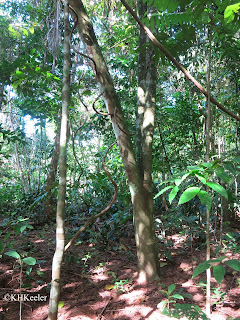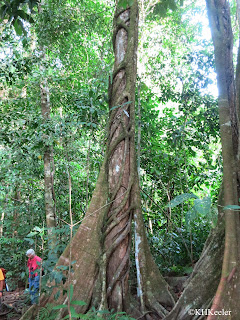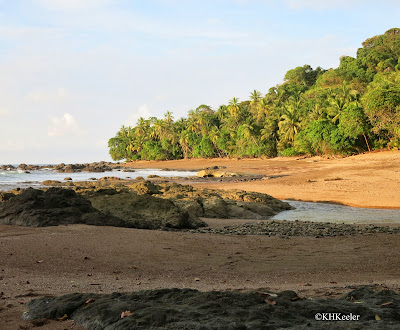 |
| looking back at the beach, Costa Rica |
I first visited to Costa Rica in 1972, with the Tropical Ecology course of the Organization for Tropical Studies, did Ph.D. research there, and have been back several times since.
Costa Rica is about the size of West Virginia. Within that small space it is very diverse. The mountains down the center create a whole series of different ecosystems, varying in temperature and rainfall and more. There is tropical rainforest on both the Atlantic and Pacific coasts, but, cut off from each other by the mountains, they have different plants and animals. On the Pacific side in the northern half of the country, severe drought from December to June combined with heavy rain the rest of the year has created a distinctive tropical dry forest.
Costa Rica is about the size of West Virginia. Within that small space it is very diverse. The mountains down the center create a whole series of different ecosystems, varying in temperature and rainfall and more. There is tropical rainforest on both the Atlantic and Pacific coasts, but, cut off from each other by the mountains, they have different plants and animals. On the Pacific side in the northern half of the country, severe drought from December to June combined with heavy rain the rest of the year has created a distinctive tropical dry forest.
In Costa Rica's southwest corner, I had a terrific time hiking in the lowland rainforest at Corcovado National Park.
Inside the rainforest was relatively dark because layers of trees over our heads cut off the sunlight. It had not rained that day, but in places the path was very muddy. The air was still and very humid.
Vines were numerous and diverse. I like vines. Here, they twisted and curled curiously.
Vines are normal in temperate forests, but uncommon in grasslands, deserts and coniferous forests. They are especially abundant in tropical forests. The big long-lived trees provide support for vines and the heavy rain and warm temperatures make it easy for them to grow very large.
For animals of all kinds, vines in the tropical rainforest are roads. Monkeys, iguanas and other lizards, snakes, ants--all kinds of animals--cross the forest on vines. Consider: hardworking ants save thousands of steps by taking a vine bridge to the next tree rather than having to walk down the trunk to the ground, across a few feet of the forest floor, and then climb up the next tree.
On the down side, vines so link rainforest trees together that when one blows over or is cut down, the vines between it and its neighbors may pull down the neighboring trees as well.(Tropical trees have shallow roots relative to their height. See Panama post)
Note on vines: vines are plants, woody or not woody, that don't hold themselves up but rely on other things, often other plants, for support. Lianas are also vines. Usually the term liana means a woody tropical vine, so that all lianas are vines but not all vines are lianas. The dramatic vines in my photos are lianas.
Flowers were uncommon, but we saw a few. Actually this is the flower stalk of this heliconia, its flowers are small and yellow and stick out from the big orange bracts. This one was pretty well through flowering.
We stepped over a line of army ants. They were moving fast and none of my photos are in focus. They are running along the stick, carrying their pupae. Army ants build a nest (bivouac) of the linked bodies of living workers, send out foragers to strip all the animals they can catch from the surrounding forest, feed those to their larvae, and then move the bivouac to another area. We saw them relocating. They didn't bother us and we didn't bother them. See army ants on this National Geographic video.
The path went on but we turned around when we reached this big strangler fig. Figs, the genus Ficus and its relatives, are in the mulberry family, Moraceae. There are some 850 species of figs around the world, but especially in the tropics. Banyan trees are figs (banyan pictures).
While many figs are trees, the strangler fig is a vine. Its fruits are little figs, unattractive to humans but much loved by birds. As a result its seeds are often deposited in bird droppings high in a tree. They germinate and grow there, sending roots down toward the soil and stems climbing up toward the light. The strangler fig wraps around the tree for support. Eventually it may encircle the tree, killing the tree because the growing vine stems steadily tighten around the tree at the same time that the tree is prevented from expanding by the vine stems. Tree circulation gets cut off--no water up, no sugars and starches down--and it dies. By then the fig may be thick enough to stand on its own and the dead host tree may rot out, leaving an eerie empty core inside the fig. I like vines but it is hard to like strangler figs, spectacular though they are.
We hiked back to the beach. We spotted white-faced monkeys high in the trees, too far for my camera, and a curassow that vanished as soon as we noticed it.
.
 |
| Pacific lowland rainforest, Costa Rica |
Inside the rainforest was relatively dark because layers of trees over our heads cut off the sunlight. It had not rained that day, but in places the path was very muddy. The air was still and very humid.
Vines were numerous and diverse. I like vines. Here, they twisted and curled curiously.
Vines are normal in temperate forests, but uncommon in grasslands, deserts and coniferous forests. They are especially abundant in tropical forests. The big long-lived trees provide support for vines and the heavy rain and warm temperatures make it easy for them to grow very large.
For animals of all kinds, vines in the tropical rainforest are roads. Monkeys, iguanas and other lizards, snakes, ants--all kinds of animals--cross the forest on vines. Consider: hardworking ants save thousands of steps by taking a vine bridge to the next tree rather than having to walk down the trunk to the ground, across a few feet of the forest floor, and then climb up the next tree.
On the down side, vines so link rainforest trees together that when one blows over or is cut down, the vines between it and its neighbors may pull down the neighboring trees as well.(Tropical trees have shallow roots relative to their height. See Panama post)
 |
| Pacific lowland rainforest, Costa Rica Note the loopy vine |
 |
| Interesting vines. The U shaped one is about a foot off the ground. |
Note on vines: vines are plants, woody or not woody, that don't hold themselves up but rely on other things, often other plants, for support. Lianas are also vines. Usually the term liana means a woody tropical vine, so that all lianas are vines but not all vines are lianas. The dramatic vines in my photos are lianas.
 |
| color in the forest, a heliconia, perhaps Heliconia latispatha |
Flowers were uncommon, but we saw a few. Actually this is the flower stalk of this heliconia, its flowers are small and yellow and stick out from the big orange bracts. This one was pretty well through flowering.
 |
| Army ants hurrying by (yellow blips on the fallen branch) see National Geographic video for action version |
 |
| big strangler fig |
 |
| strangler fig |
The path went on but we turned around when we reached this big strangler fig. Figs, the genus Ficus and its relatives, are in the mulberry family, Moraceae. There are some 850 species of figs around the world, but especially in the tropics. Banyan trees are figs (banyan pictures).
While many figs are trees, the strangler fig is a vine. Its fruits are little figs, unattractive to humans but much loved by birds. As a result its seeds are often deposited in bird droppings high in a tree. They germinate and grow there, sending roots down toward the soil and stems climbing up toward the light. The strangler fig wraps around the tree for support. Eventually it may encircle the tree, killing the tree because the growing vine stems steadily tighten around the tree at the same time that the tree is prevented from expanding by the vine stems. Tree circulation gets cut off--no water up, no sugars and starches down--and it dies. By then the fig may be thick enough to stand on its own and the dead host tree may rot out, leaving an eerie empty core inside the fig. I like vines but it is hard to like strangler figs, spectacular though they are.
We hiked back to the beach. We spotted white-faced monkeys high in the trees, too far for my camera, and a curassow that vanished as soon as we noticed it.
.
 |
| The beach -- Pacific coast, Costa Rica |
And that was a glimpse of what you might see on a morning walk in southwestern Costa Rica.
No comments:
Post a Comment